Spiritual Heritage, shaped and revived by the flow of time and history
It all begins with Lord Krishna, the Supreme Being,
whose transcendental pastimes in Vrindavana became the heart of the Gaudiya Vaishnavism tradition. The teachings of Lord Krishna were carried forth by his eternal associates and incarnations, including Sri Chaitanya Mahaprabhu, who, in the 15th century, reignited the flame of divine love and devotion. Mahaprabhu’s mission was not just to spread the holy names of Krishna but also to reveal the deepest truths of bhakti.
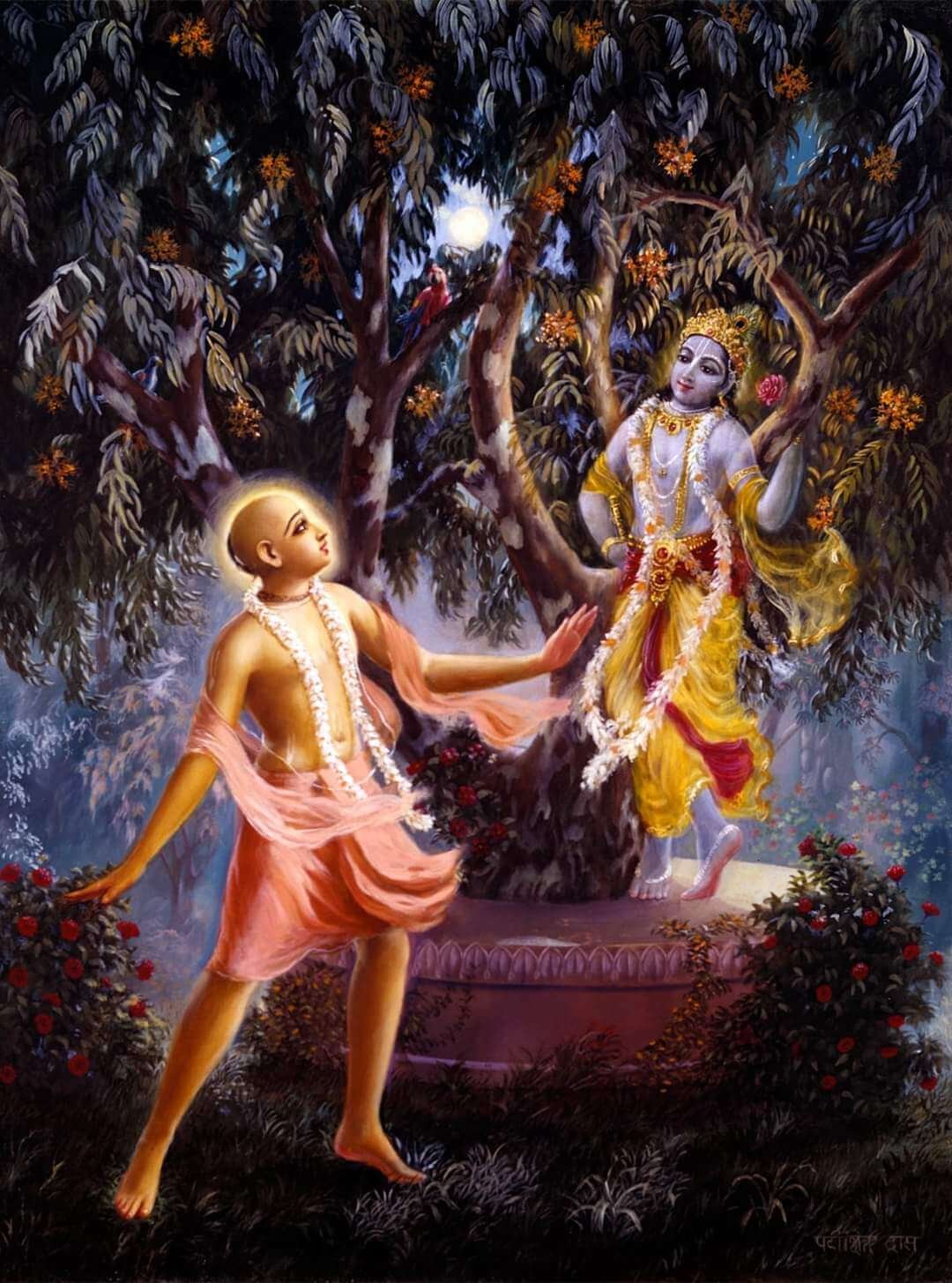
Premavataar Shree Chaitanya Mahaprabhu, on His mission to preach Hari Naam Sankirtan across the villages of southern India, brought divine love wherever He went.
The holy names from His lips felt like nectar pouring directly into one’s ears, making it impossible to remain attached to the physical self. Thousands of men and women felt relief from the blazing fire of material existence, and even the wretched, miserable and fallen souls were completely rejuvenated to be virtuous and happy.
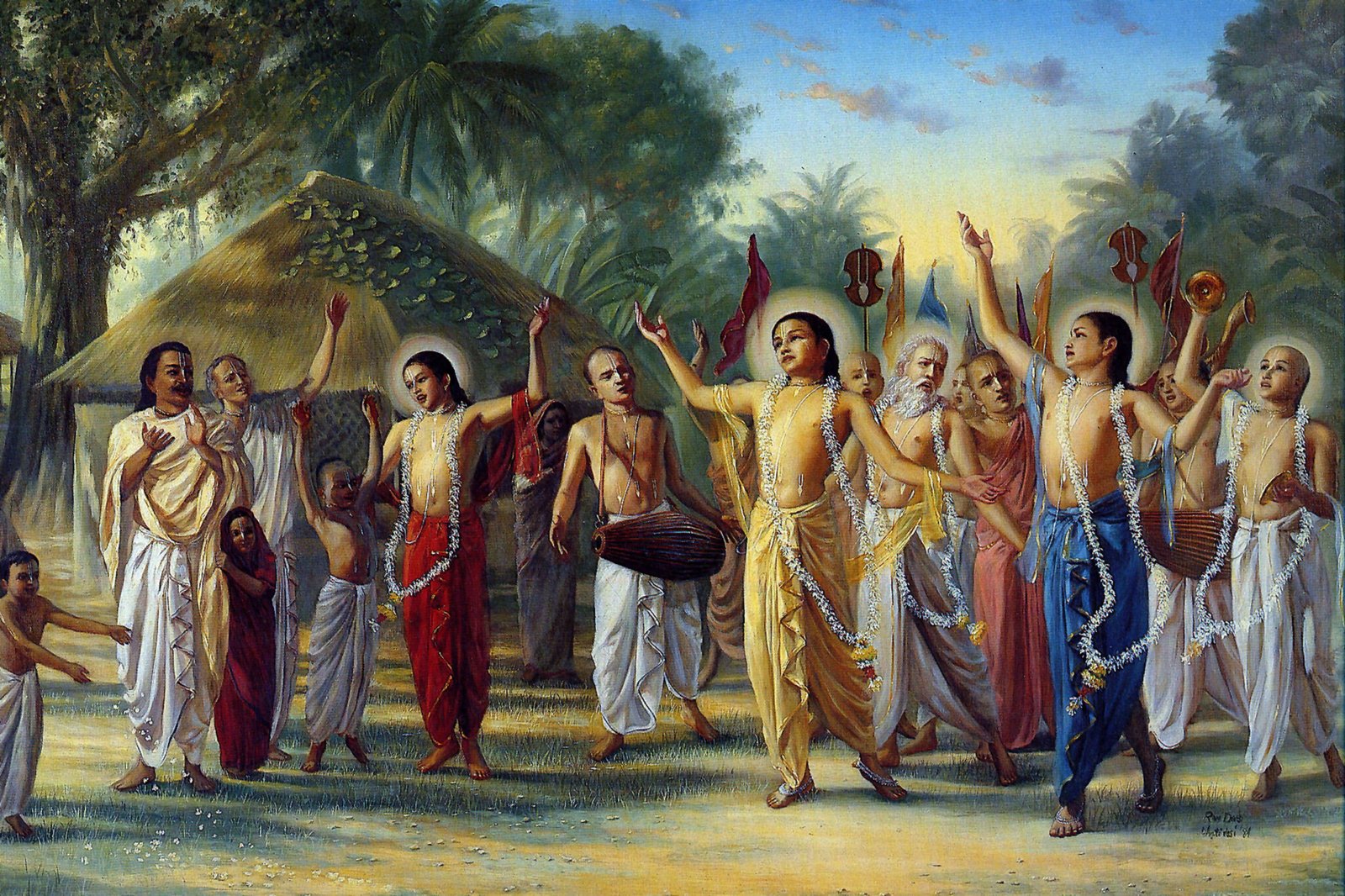
While showering the rain of God’s love everywhere, without regard for time or place, Shree Chaitanya Mahaprabhu arrived at the ancient holy site of Sri Rangam on the sacred banks of the Kaveri river.
He visited the Ranga Kshetra in the Christian year 1511. The Sri Rangam temple was immense, its towering crest piercing the sky. Day and night, countless pilgrims came and went, seeking the darshan of Lord Ranganath. The temple hall echoed with the resonant chants of hundreds of brahmanas reciting Vedic hymns.
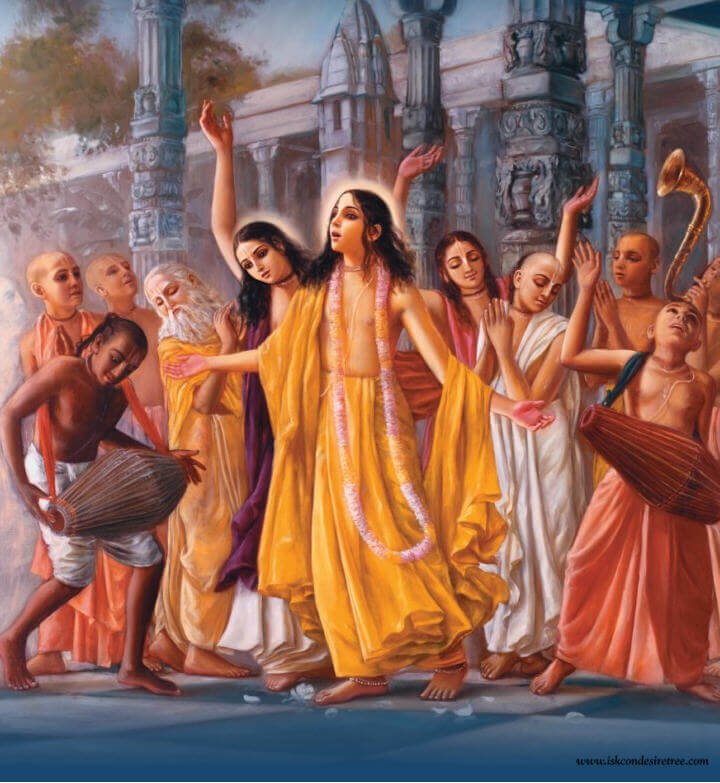
As the halls resounded with the transcendental vibrations of Sri Hari’s name, He came before the Deity and fell to the ground, like a tree felled by the wind. To some, it seemed as though they saw a mountain of gold rolling upon the floor. Sri Venkata Bhatta, upon witnessing this divine persona, became restless with ecstasy. His heart, flooded with devotion, compelled him to rise and clear the crowd so the Lord could freely engage in chanting and dancing. Venkata Bhatta had two brothers, Tirumalla Bhatta and Prabodhananda Sarasvati. They all belonged to the Ramanuja Sampradaya, with Prabodhananda Sarasvati being a tridandi sannyasi of that order.
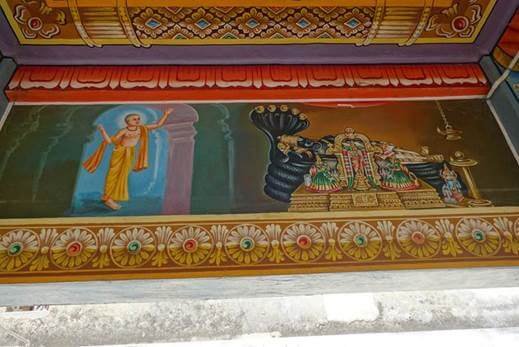
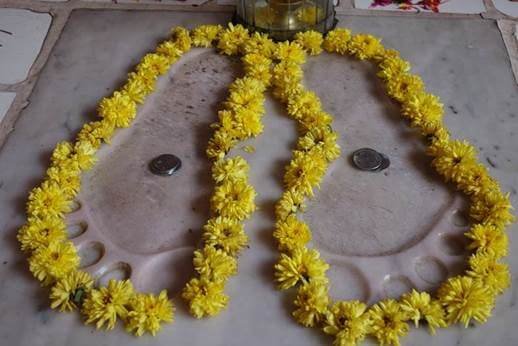
When the Lord returned to His external consciousness after sankirtan, Venkata Bhatta approached Him and humbly took the dust of His lotus feet. Mahaprabhu gazed at him, exclaiming, “KRISHNA! KRISHNA!” and embraced him firmly. Sri Venkata Bhatta then invited Mahaprabhu to his home. Upon bringing Him there, he reverently washed His lotus feet, and together with his family, drank the sanctified water. The household of Sri Bhattaji was overwhelmed with joy.
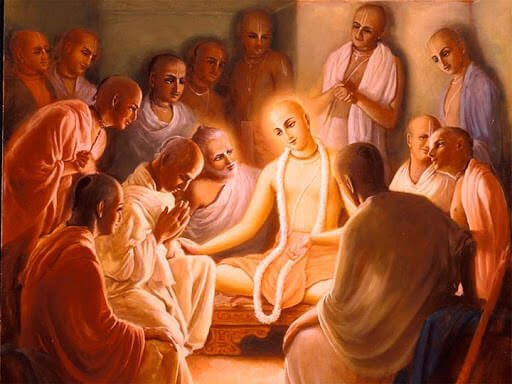
Venkata Bhatta had a son named Gopal, who was still a child at the time.
When the boy came to offer his obeisances at the lotus feet of Mahaprabhu, the Lord picked him up and affectionately seated him in His lap. Mahaprabhu would call Gopal after finishing His meal and lovingly offer him His remnants. This way, He prepared the boy for the position of Acharya that Gopal was to take on later. After residing at Vyenkata Bhatta’s house during the four months of the rainy season (Chaturmasya), Mahaprabhu prepared to continue His journey to the South. Venkata Bhatta’s household overflowed with a tide of tears of love in anticipation of His departure. Gopal fell at His lotus feet, unable to bear the thought of separation. Moved by the boy’s devotion, Mahaprabhu stayed for a couple more days to console him. Pleased with Gopal Bhatta Goswami’s sincere service and devotion, Sri Caitanya Mahaprabhu initiated him and instructed him to move to Vrindavana after his parents’ departure, where he was to perform bhajan and compose writings. He also advised him to serve his mother and father faithfully and to always remain absorbed in chanting Krsna’s glories until the time came to journey to Vrindavana.
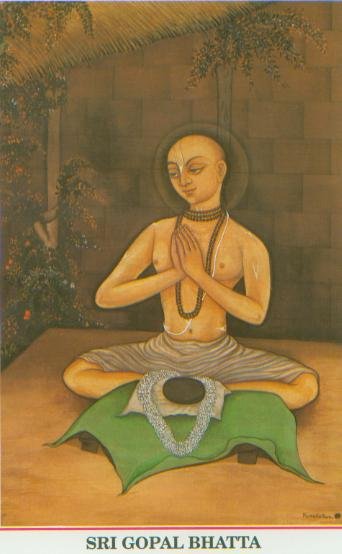
Gopal quickly became proficient in grammar and poetry and soon began studying Vedanta. His uncle, Prabodhananda, specifically guided him in the devotional scriptures (Bhakti-shastra).
Gopal Bhatta constantly meditated on the lotus feet of Mahaprabhu, yearning for the day he might meet Him again. Yet, he could not leave his aged mother and father behind. In their final days, his parents called Gopal to them and instructed him to go to the lotus feet of Mahaprabhu in Vrindavana. Meditating on His divine lotus feet, they peacefully departed to join Him in His eternal lila.
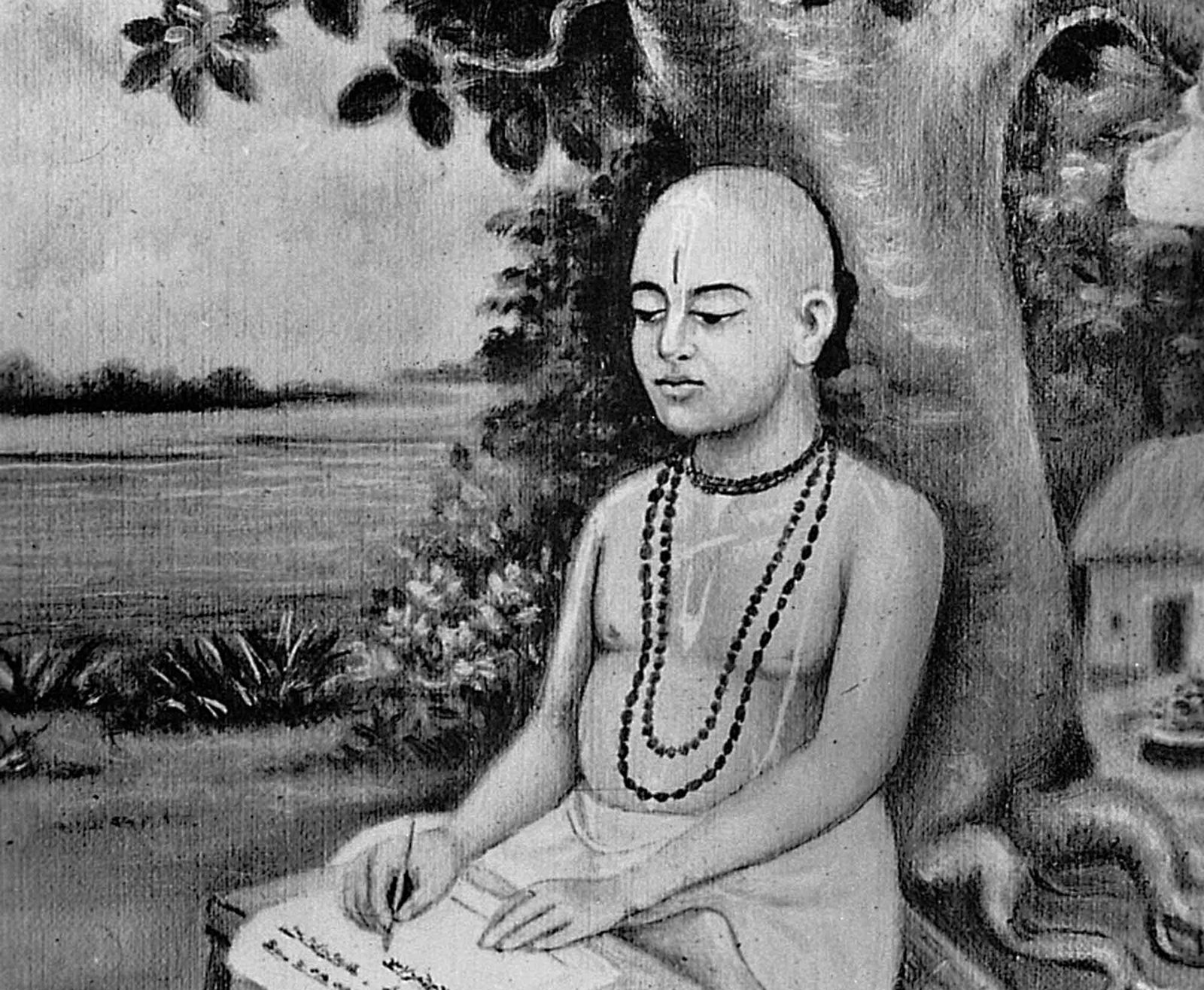
At the age of thirty, Gopala Bhatta Gosvami came to Vrindavana. Missing the opportunity to meet Sri Caitanya Mahaprabhu saddened him deeply.
Upon his arrival, Rupa Gosvami immediately sent word to Mahaprabhu to inform Him of Gopal’s presence in Vrindavana. Mahaprabhu had previously mentioned to Rupa and Sanatana that Gopal Bhatta would one day arrive in Vrindavana. Thus, when he came, they welcomed him with the same care and affection as they would their own brother, and they immediately became lifelong companions.
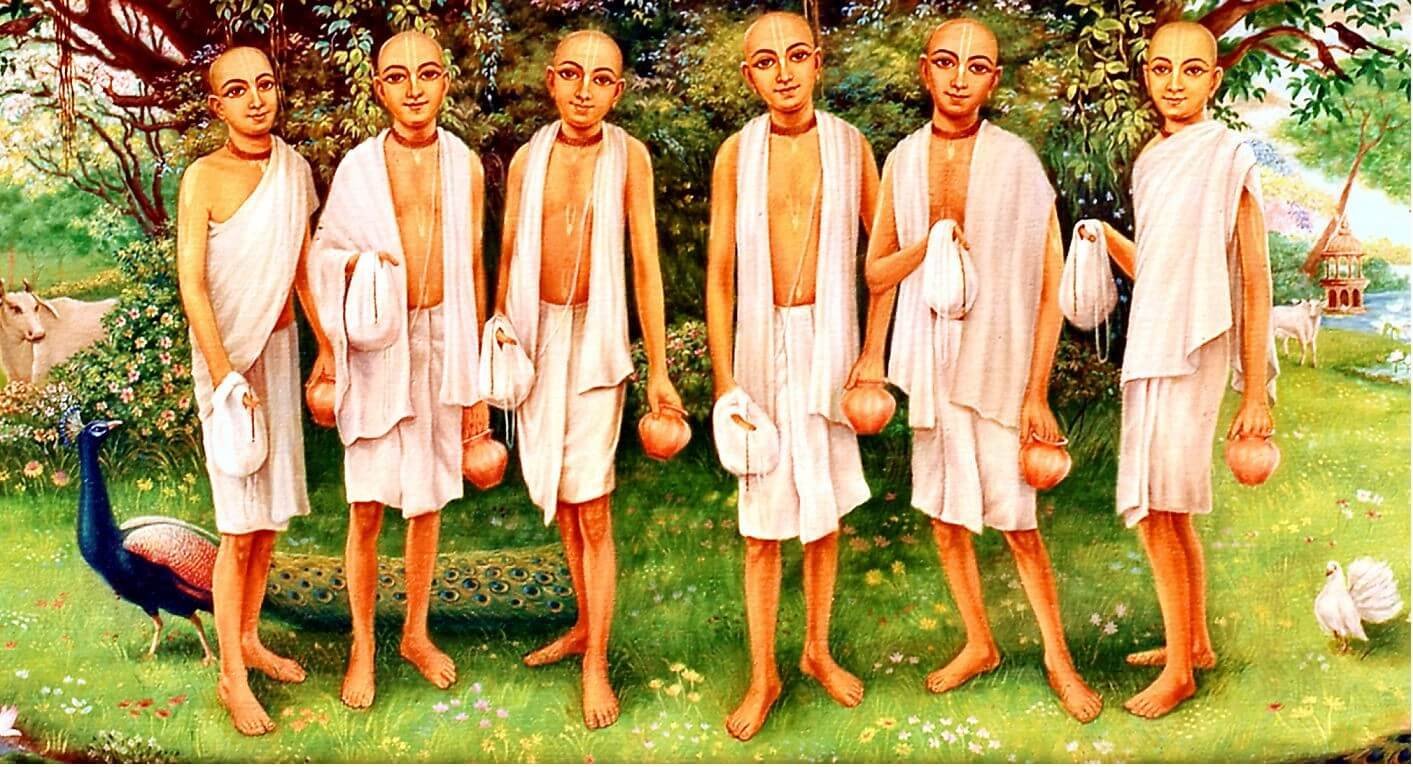
Gopal Bhatta’s journey to Vrindavana brought him into the fold of the six Goswamis, where he contributed to their sacred work. In Vrindavana, Gopal Bhatta’s humility and devotion became evident. Despite being one of the six Goswamis, he always maintained an attitude of meekness, contributing to the sacred literature, including the Hari-bhakti-vilasa and Sat-kriya-sara-dipika, while avoiding any personal glorification. His humility and spiritual depth left an indelible mark on the Gaudiya Vaishnavism tradition.
The all-knowing Supreme Personality of Godhead, Sri Caitanya Mahaprabhu, was very pleased to hear of Gopal Bhatta’s arrival. Through the messenger, He sent His personal wooden sitting plank (patta), a pair of garments, and an upper cloth (uttara or chaddar). Receiving these sacred gifts, Gopal Bhatta was overwhelmed with ecstasy and worshipped them as the prasad of Mahaprabhu. When he worshipped his Deities, he would sit on that wooden plank.
This patta (wooden seat) and the clothes of Mahaprabhu are still revered and worshipped at the Radha-Ramana Mandir.
Gopala Bhatta, like Rupa and Sanatana, had no fixed residence and spent his nights in various kunjas (forest groves).
He devoted his time to studying the scriptures and composing various literatures. After Sri Caitanya Mahaprabhu’s disappearance, Gopala Bhatta Gosvami felt intense separation from the Lord. To console him, the Lord appeared in a dream and instructed, “If you want My darshan, make a trip to Nepal.” Following this divine instruction, Gopala Bhatta traveled to Nepal and bathed in the sacred Kali-Gandaki River. As he dipped his water pot into the river, several Shaligrama Shilas mysteriously entered it. He returned the Shilas to the river, but each time he refilled his pot, the Shilas re-entered. On the third attempt, he found twelve Shaligrama Shilas sitting in his pot. Realizing this as the Lord’s mercy, he kept the Shilas and returned to Vrindavana.

Sri Gopala Bhatta Gosvami worshipped twelve Shaligrama Shilas, carrying them with him wherever he went, tied securely in a cloth at the corner.
He also kept clothes and ornaments with the Shilas, cherishing the desire to one day adorn the Lord with them. One day, as Gopala Bhatta Gosvami meditated on the half-man, half-lion form of the Supreme Lord, who had manifested from a pillar in Hiranyakashipu’s palace, he prayed with deep transcendental lamentation: “Oh my Lord, You are so merciful and always fulfill the desires of Your devotees. I long to serve You in Your form with arms and legs, a blissful smiling face, and lotus eyes. If I had such a Deity, I could lovingly decorate Him with these clothes and ornaments.”
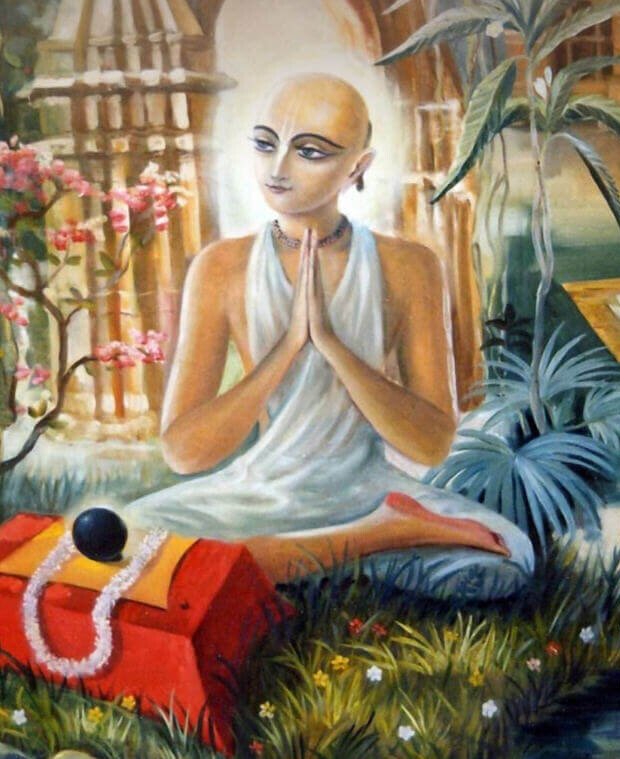
In the evening, after offering bhoga to his Shaligrama Shilas, Gopala Bhatta Gosvami put them to rest, covering them with a wicker basket. Late at night, he took a little rest, and early in the morning, he went to bathe in the Yamuna River. Upon returning, he uncovered the Shaligramas to begin their puja and was astonished to see that among them was a Deity of Krishna playing the flute. There were now eleven Shilas and the Deity. The “Damodara Shila” had transformed into the beautiful threefold-bending form of Tri-bhanga Krishna.
Floating in an ocean of ecstasy, Gopala Bhatta fell to the ground, offering his dandavats, and recited prayers and hymns in glorification. When Rupa and Sanatana Gosvamis as well as many other devotees received news of this miraculous event they came running to see the Lord. Gazing on the Lord’s transcendental form, which bewildered all the living entities of the many various planets, they all bathed Him with their tears.
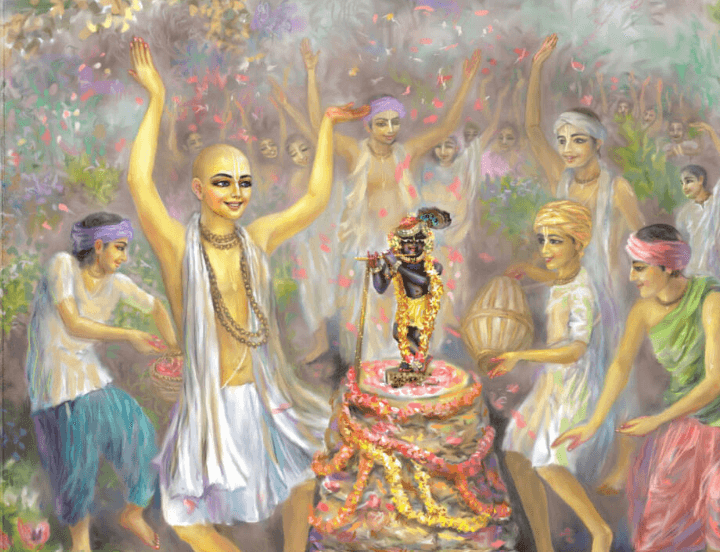
This Deity, named “Sri Radha-Raman Deva” by the Gosvamis, appeared on the full moon day of Vaisakha in the year 1542. The miraculous appearance of Sri Radha-Raman took place on the day after Sri Nrisimha Chaturdasi and is celebrated annually on that auspicious day. On this occasion, 500 liters of milk and a variety of sweets and other offerings are presented for the Lord’s pleasure. The Radha-Raman temple is renowned for maintaining the highest standard of Deity worship in all of Vraj.
Among the original Deities of Vrindavana, only Sri Radha-Ramanji, apart from Vrinda Devi, has never been moved to Jaipur. Sri Radha-Ramanji continues to be worshipped in Vrindavana, near Nidhi Van Kunj, within the temple compound. Although there is no visible Deity of Srimati Radhika alongside Sri Radha-Ramanji, a place is set to His left for Her. In this way, the Acharyas worship Sri Radha and Ramanji together. Sri Radha-Raman Deva is unique among Deities, with intricate features such as fingernails and teeth. Remarkably, parts of the original Shaligrama Shila from which He manifested can still be seen on the back of His form.
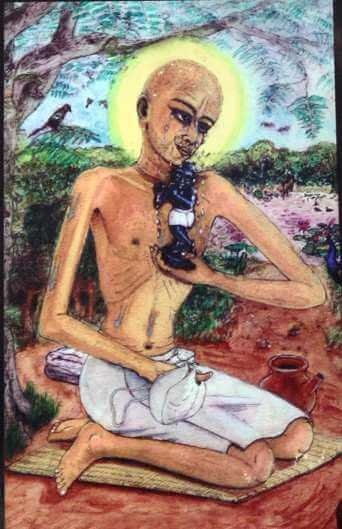
One of the most significant contributions of Gopal Bhatta was the founding of the Radha Ramana temple, a sacred place of worship that remains one of the most revered in Vrindavana.
The temple, with its rich history, continues to serve as a center for devotion and spiritual guidance. The legacy of Gopal Bhatta’s devotion lives on through the generations of Goswamis who have faithfully maintained the worship of Radha Ramana and the teachings of Lord Chaitanya.
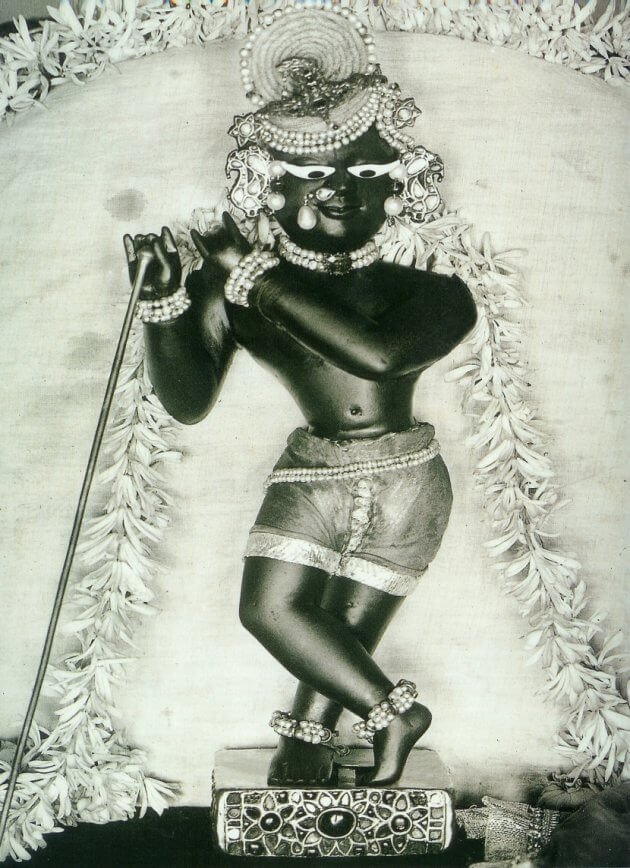
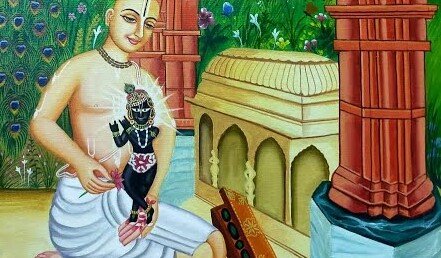
Through the vision of Lord Chaitanya, Gopal Bhatta was chosen to carry forward the lineage of spiritual teachers, and he imparted this responsibility to his disciple, Damodar Das Goswami, ensuring the continued guidance of devotees in their journey of devotion.
The Goswamis of the Radha Ramana temple have, for over 500 years, upheld the teachings of Gopal Bhatta, serving as spiritual leaders and guiding souls toward the highest form of devotion.
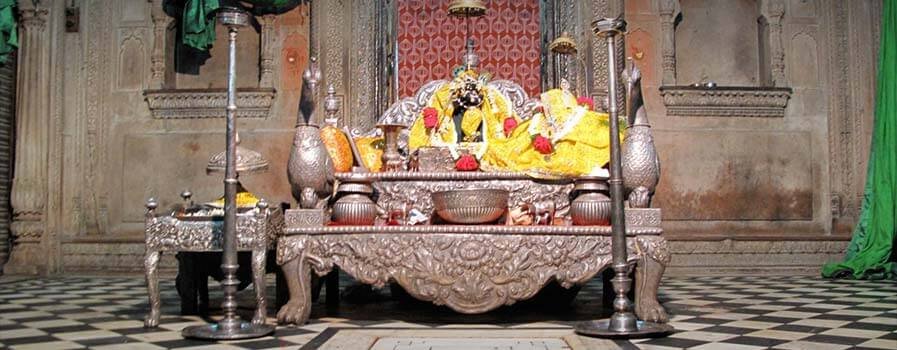
Born into this sacred lineage, Vaishnavacharya Shree Abhishek Goswami Maharaj carries forward the profound legacy of his ancestors, while offering teachings that resonate deeply with the needs of the modern world.
Abhishek Goswami Maharaj was born on January 3, 1975, in Vrindavan, Uttar Pradesh, India, into a distinguished Brahmin family. A 38th-generation descendant of the revered Goswami Kul of the Shree Radha-Raman Temple in Vrindavan, Maharaj Shree serves as the Gaddipati (Head) of one of the most prestigious temples in Vraj. He continues the unbroken tradition established by Gopal Bhatt Goswami, a direct associate of Sri Chaitanya Mahaprabhu.
Maharah Shree or Jai Jai, as he is referred by his disciples and admirers, has devoted over twelve years to the study and research of spiritual scriptures such as the Shreemad Bhagavatam, Shreemad Bhagavad Gita, Valmiki Ramayana, Sri Chaitanya Charitamrita, the Upanishads, and more. His studies also extend to comparative analyses of Buddhism, Jainism, and Sikhism, reflecting his inclusive approach to spirituality.
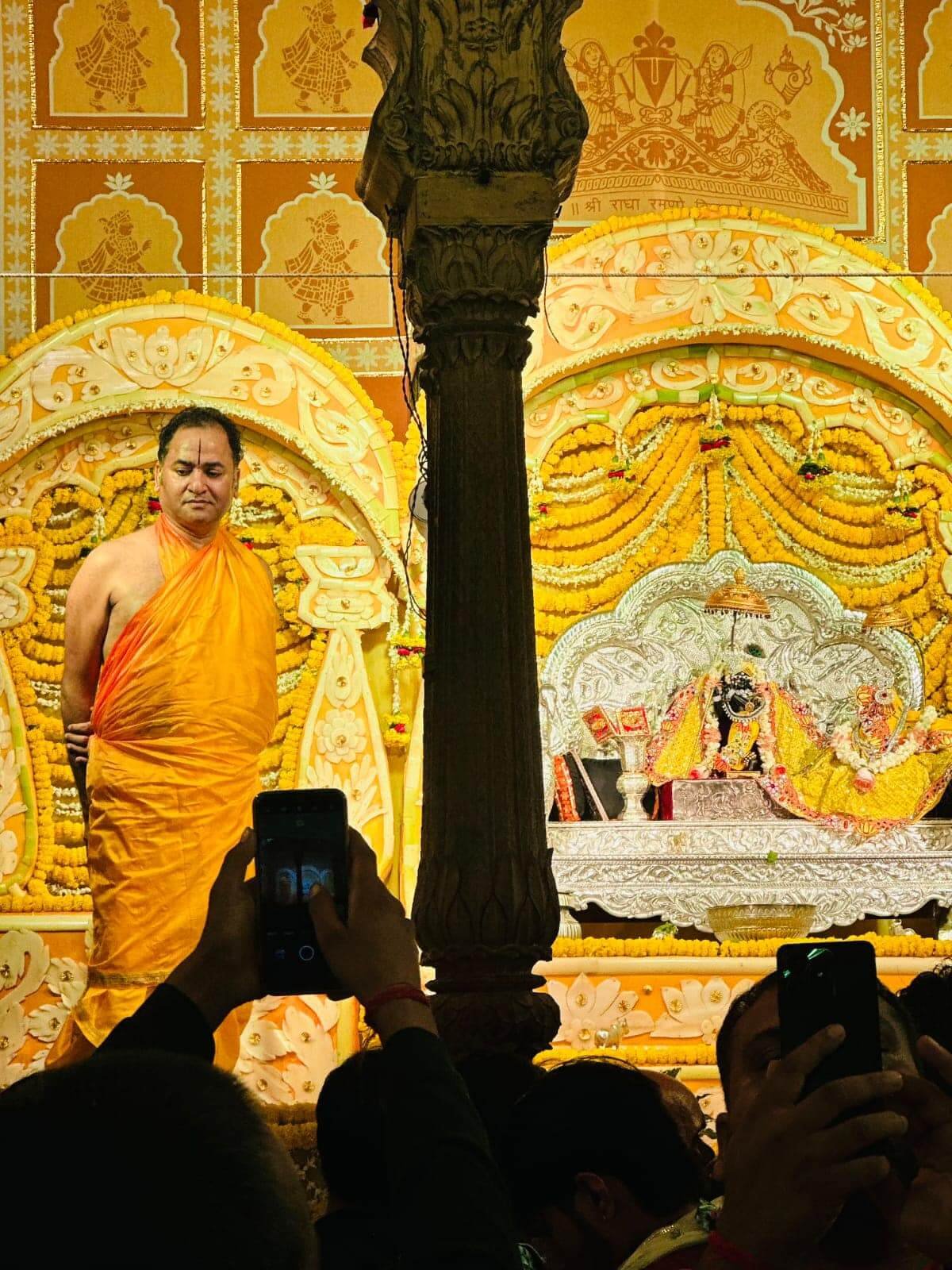
Renowned for his exceptional interpretations of ancient scriptures, Maharaj Shree connects timeless wisdom to contemporary challenges. Fluent in English, Hindi, and Sanskrit, he delivers inspiring discourses, kathas, seminars, and workshops that draw large audiences across India and abroad. His seminars offer practical insights into management styles rooted in Indian wisdom that are sponsored by corporates, educational institutions, media houses, and social organizations.
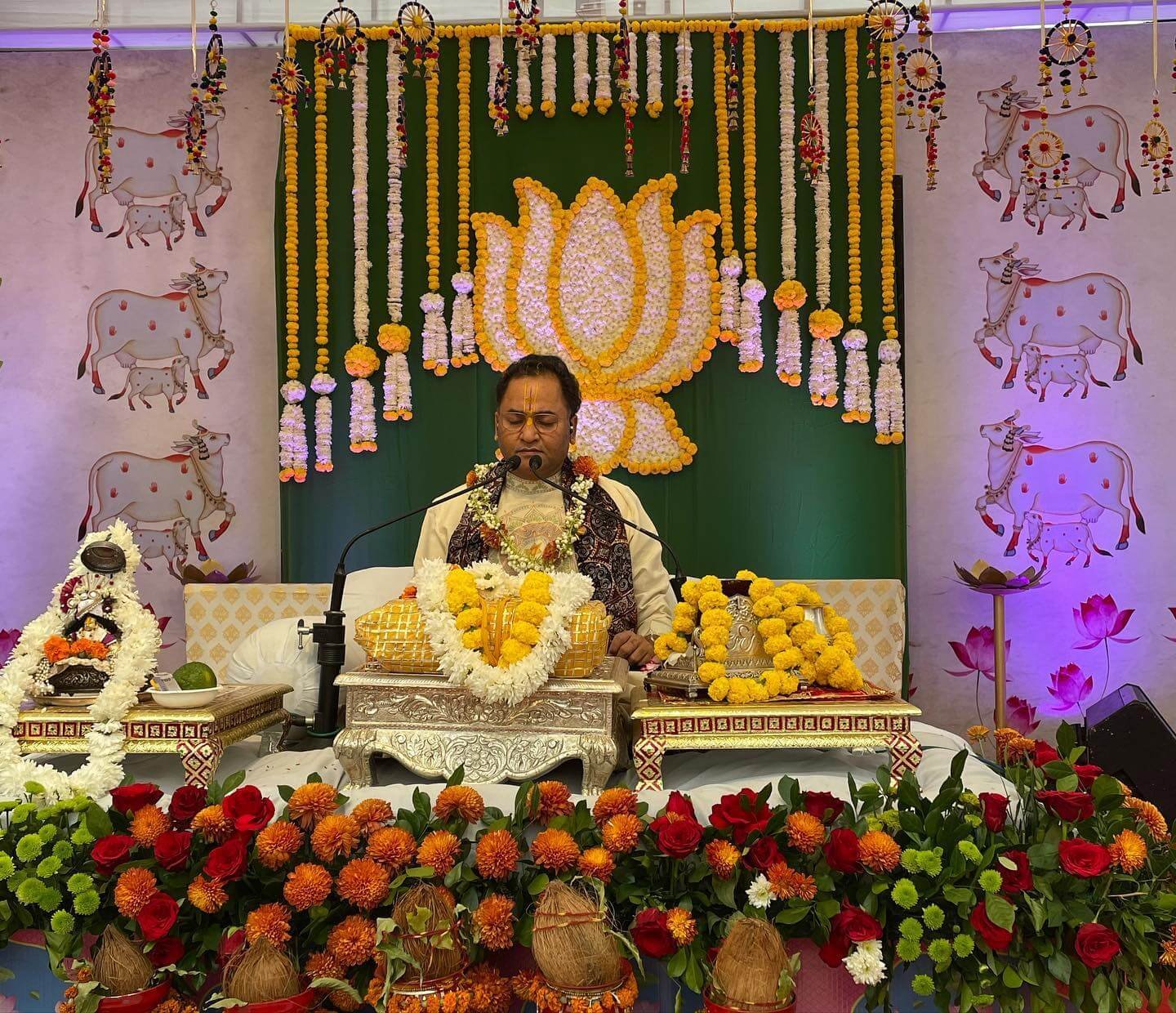
Though based in Vrindavan, where he lovingly tends to the sacred peacocks and offers his heartfelt devotion to Sri Radha Raman Dev Ji, Maharaj Sri’s influence spans the globe. His relentless travels take him across Europe, South America, the UAE, South Africa, and India, where he inspires individuals to lead lives of purpose, joy, and inner peace. Whether leading his disciples through the rugged terrain of Kailash Parikrama in Tibet or sharing moments of lightheartedness, he demonstrates how devotion, mindfulness, and living with intent can transform every aspect of life.
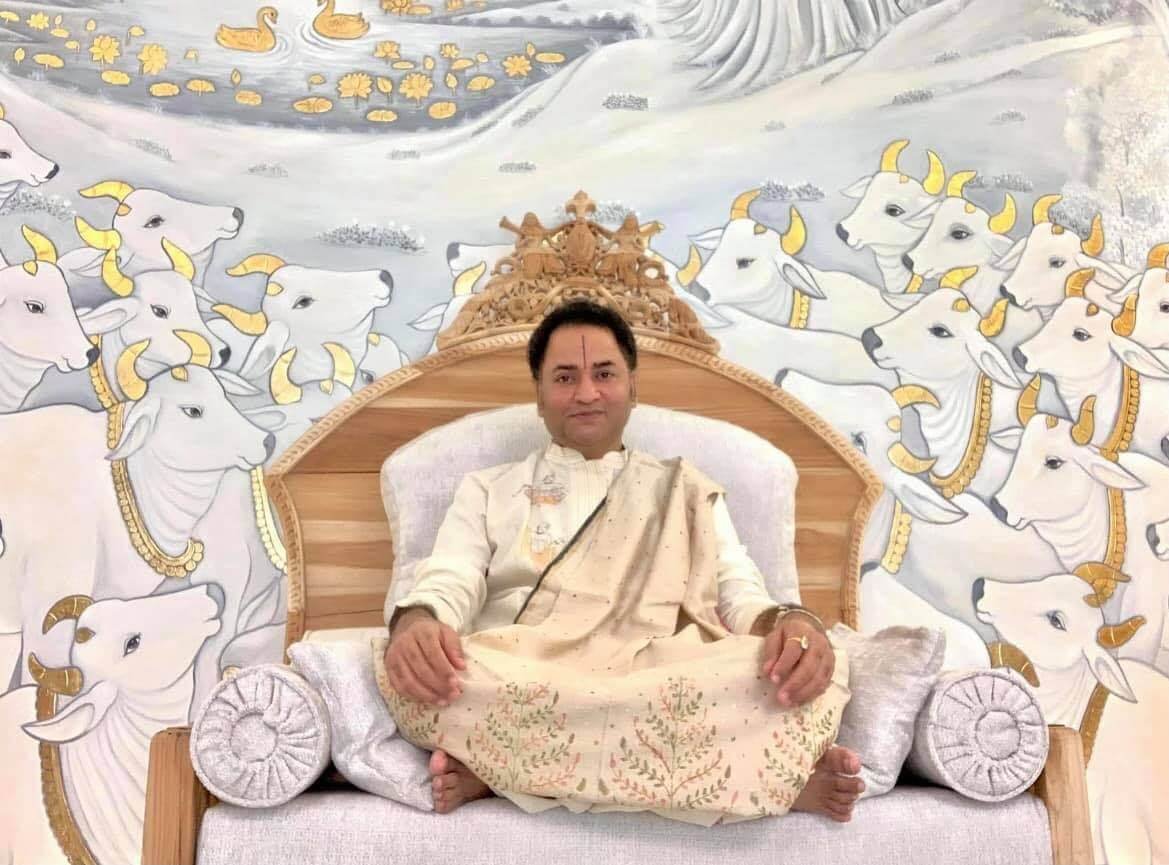
Vaishnavacharya Shree Abhishek Goswami Ji Maharaj, the 38th successor in the revered spiritual lineage of Sri Chaitanya Mahaprabhu continues the unbroken line of revered spiritual masters who have preserved and propagated the teachings of Bhakti Yoga across centuries.
Maharaj Shree illuminates hearts not only with the legacy he has inherited by legitimate succession but also through his personal dedication to showing people the true meaning of love and devotion.

The Lineage
01
Shree Krishna
02
Lord Brahma
03
Dev Rishi Narad
04
Shree Veda Vyas
05
Shree Jagad Guru Madhavacharya
06
Shree Narhari
07
Shree Madhava
08
Shree Ashobh
09
Shree Jayateerth
10
Shree Gyan Sindhu
11
Shree Dayanidhi
12
Shree Vidyanidhi
13
Shree Rajendra
14
Shree Jaya Dharma
15
Shree Purushottam
16
Shree Brahmanya
17
ShrShree Vyasa Teerth
18
Shree Lakshmi Pati
19
Shree Madhvendra Puri
20
Shree Ishwar Puri
21
Shree Chaitanya Mahaprabhu
22
Shree Gopal Bhatt Goswami
23
Shree Damodar Das Goswami
24
Shree Harinath Goswami
25
Shree Sundardas Goswami
26
Shree Vanshidhar Goswami
27
Shree Haribhakt Goswami
28
Shree Bramhanand Goswami
29
Shree Nitilal Goswami
30
Shree Motilal Goswami
31
Shree Krishna Dayal Goswami
32
Shree Anandilal Goswami
33
Shree Kallu Lal Goswami
34
Shree Hanumandas Goswami
35
Shree Narsing Das Goswami
36
Shree Krishna Chandra Goswami
37
Shree Sharad Chandra Goswami
38
Shree Abhishek Goswami
39



